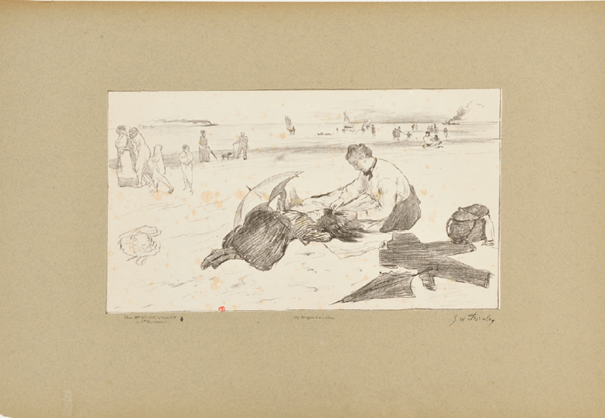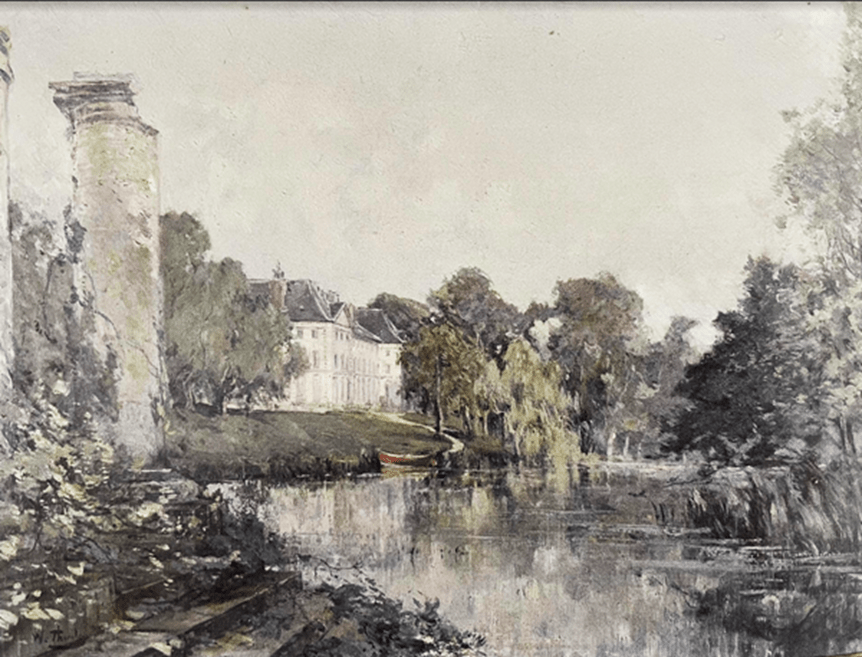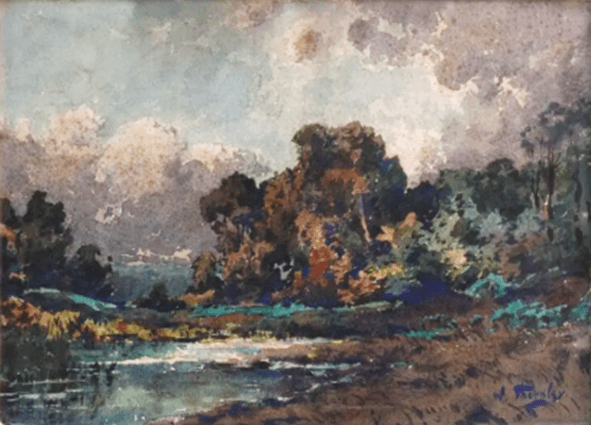Bain de mer. Lithographie de William Thornley (1857-1935) d’après Edgar Degas (1834-1917). Origine du visuel : INHA (0618_doucet_FEST260) – Sous licence Ouverte. Une des quinze lithographies originales tirée de l’album édité par Boussod, Valadon & Cie, 1889. L’album a été imprimé à 100 exemplaires par la maison Becquet Frères.
Dimensions du visuel : 19×34,2cm
La peinture à l’huile de Degas (peinture à l’essence) « Scène de plage » qui servit de modèle à William Thornley pour cette lithographie (47,5 x 82,9cm) fait aujourd’hui partie des collections de la National Gallery à Londres (NG3247) suite à un Legs de Sir Hugh Lane à la National Gallery, Londres. Une autre institution, La Hugh Lane Gallery à Dublin bénéficie d’un prêt de cette œuvre à long terme depuis 2019 (jusqu’à 2026).
Selon les commentaires de la National Gallery, cette scène de plage aurait été initiée en 1869 (année d’un séjour de Degas sur la Côte nord de la France), et terminée ensuite dans son atelier parisien. Le catalogue raisonné de Michel Schulman situe cette œuvre aux alentours de 1877 (Circa 1877). Comme précisé dans le commentaire de la National Gallery en regard de l’œuvre, « Edgard Degas a utilisé une technique particulière pour réaliser cette peinture (a majeure partie de l’huile a été retirée avec du papier buvard, dilué avec de la térébenthine pour donner l’effet d’une aquarelle. «
Certains y voient de façon explicite l’influence de son ami Manet et de la mode de l’époque pour le japonisme (femme peignant les cheveux).
Le tableau appartenait au collectionneur d’art et industriel français Henri Rouart (1833-1912), le père d’Hélène Rouart, dont Degas a peint le portrait (vers 1886). La scène de plage a été exposée à la troisième exposition impressionniste en 1877 avant d’être vendue en 1912 à Sir Hugh Lane. (Voir également les précisions apportées sous la référence MS-1142 du catalogue raisonné de Michel Schulman)

Sea bathing. Lithograph by William Thornley (1857-1935) from a model of Edgar Degas (1834-1917). Origin of the visual: INHA (0618_doucet_FEST260) – Under Open License. One of the fifteen original lithographs from the album published by Boussod, Valadon & Cie, 1889. The album was printed in 100 copies by Becquet Frères. Visual dimensions: 19×34.2cm
Degas’ oil painting (petroleum painting) “Scène de plage” which served as a model for William Thornley for this lithograph (47.5 x 82.9cm) is now part of the collections of the National Gallery in London (NG3247- following a Bequest from Sir Hugh Lane to the National Gallery, London. Another institution, the Hugh Lane Gallery in Dublin, has had a long-term loan of this work since 2019 (until 2026).
According to the National Gallery’s comments, this beach scene was initiated in 1869 (the year of Degas’ stay on the North Coast of France), and then completed in his Paris studio. Michel Schulman’s catalogue raisonné dates this work to around 1877 (Circa 1877). As specified in the National Gallery’s commentary opposite the work, « Edgard Degas used a particular technique to create this painting (most of the oil was removed with blotting paper, diluted with turpentine to give the effect of a watercolor. »
Some see in it the explicit influence of his friend Manet and the fashion of the time for Japonism (woman combing hair).
The painting belonged to the French art collector and industrialist Henri Rouart (1833-1912), the father of Hélène Rouart, whose portrait Degas painted (circa 1886). The beach scene was exhibited at the third Impressionist exhibition in 1877 before being sold in 1912 to Sir Hugh Lane. (See also the details provided under reference MS-1142 of Michel Schulman’s catalogue raisonné)



